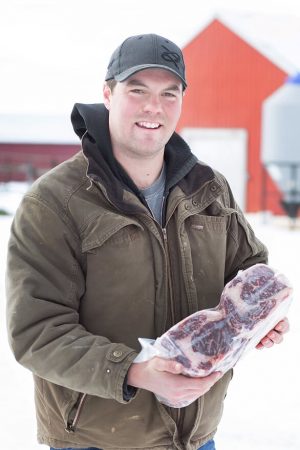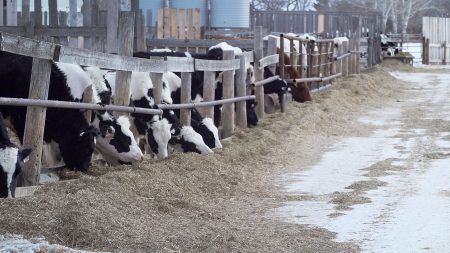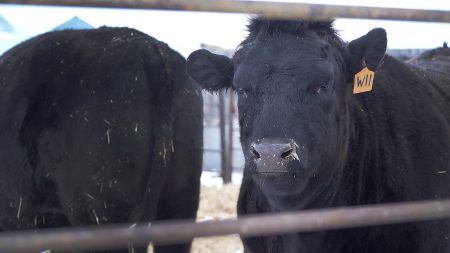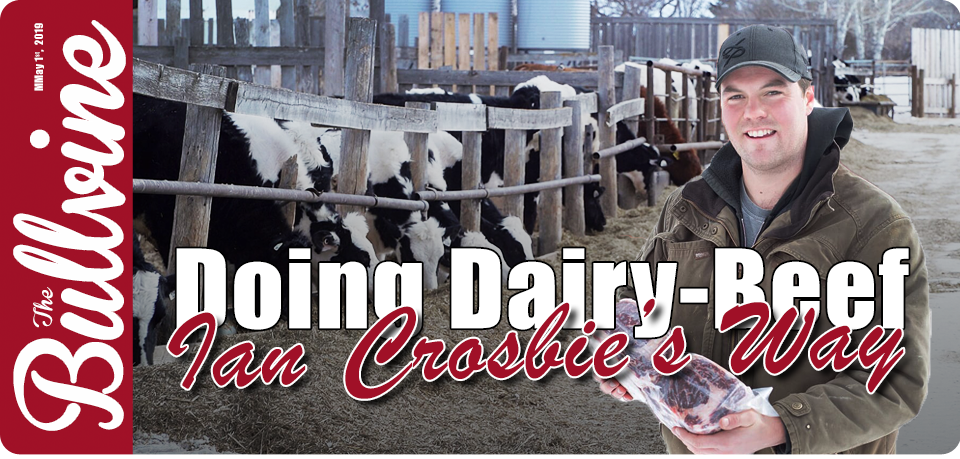 Every dairy farmer is also a beef producer – even more, today than in the past. How so? Today there is considerably less demand for springing bred or newly calved heifers. Also, we must factor in sexed semen, and more effective on-farm cattle management and dairy farms are being advised to breed from 30% to 50% of their lower producing or lower profit cows and heifers to beef sires. The Bullvine wishes to share with you how one innovative dairyman, Ian Crosbie owner of Benbie Holsteins from Saskatchewan Canada, approached this profit opportunity.
Every dairy farmer is also a beef producer – even more, today than in the past. How so? Today there is considerably less demand for springing bred or newly calved heifers. Also, we must factor in sexed semen, and more effective on-farm cattle management and dairy farms are being advised to breed from 30% to 50% of their lower producing or lower profit cows and heifers to beef sires. The Bullvine wishes to share with you how one innovative dairyman, Ian Crosbie owner of Benbie Holsteins from Saskatchewan Canada, approached this profit opportunity.
The Usual Approaches to Dairy-Beef
New born male calves are quite variable in price going from no value, even a negative value when sold at sales barns, to over $150 depending on breed, time of year and number of calves on the market. With less demand in North America for milk-fed veal calves, even choice new born Holstein calves are not bringing the returns they once did.
Some farms have always bred a portion of their animals to beef sires to garner higher dropped calf prices. But that has not been a widespread practice.
Today with the extensive use of sexed semen on the top females in a herd and the surplus of fresh first calvers, dairy farms are looking to find a way to generate revenue from the lower end of their herds by producing animals that will enter the meat trade. Therefore they use beef sires on a portion of their herd. In some cases, they are even breeding all females beef and buying all their replacement milkers on the depressed price market for newly calved females.
Dairy-Beef Not All Roses
Dairy farms that retain all their half beef animals and grow them out for meat find no problem with growing them. They have the feed and the facilities, but when it comes time to send them to market, they face packer buyer price discrimination against part dairy animals in the live animal auction ring. Breaking even or no profit on raising these animals for the meat market was not what the dairy farms had as their objective.
If selling their half beef dropped calves at the farm or at auction, dairy farms can obtain from 2x to 3x the price for a dairy calf, so most farms take that route for marketing their dairy-beef calves.
Setting the Benbie Scene
 Benbie Holsteins, a high genetic high performance 160 milking cow Holstein family farm, has for a few years been breeding a portion of their lower end females to Angus sires.
Benbie Holsteins, a high genetic high performance 160 milking cow Holstein family farm, has for a few years been breeding a portion of their lower end females to Angus sires.
Ian explains his decisions to investigate in using more beef sires as follows: “There are multiple reasons that breeding the dairy herd to beef semen made sense for us at Benbie Holsteins. The main reason for beginning breeding a portion of our herd to beef semen was to try to control how many replacement two-year-olds we were calving in. And from which genetics we were getting our replacements. It’s no secret that over a ten-year period extra replacements are typically sold for less than the cost of raising them. Sexed semen has added to the problem of surplus dairy heifers, and we did not want to overstock or further invest in our heifer facilities for replacements that were undervalued.”
Ian continued in his explanation: “We focus heavily on our top end genetics in the Holstein herd and through genomic testing, performance testing, ET, IVF and sexed semen we can genetically optimize our next generation of replacement females. Being located in Saskatchewan, we have good demand from beef producers for cross-bred Angus/Holstein calves, especially during calving season where those calves can bring up to $500 as drop calves.”
Ian Did His Homework
“After researching and learning about the Wagyu breed, mainly through YouTube, I became very interested in producing Wagyu/Holstein cross beef. This has led to the launch of Saskatchewan Snow Beef in 2018.”
When asked ‘Why Wagyu?’ Ian’s response was: “Wagyu beef is the best money can buy, plain and simple. The breed is world renowned for its ability to deposit fat (marbling) throughout the muscling of the animal — the intense marbling results in a juicy, tender steak. The ‘Canadian Prime’ grade for beef is the highest standard. Approximately 1-2% of all Canadian beef is graded Prime. The Wagyu breed will reach at least Prime over 80% of the time due to their superior marbling ability. Wagyu crosses well with Holsteins. Calving ability is second to none; we have yet to assist a calving. And coming from two intensely bred parent lines the cross offspring have hybrid vigour. We have found the resulting calves to be extremely aggressive and healthy.”
Ian Received Great Advice
Ian himself is a great contributor in the dairy cattle industry; however, in this endeavour, he sought out and got valuable advice from Wagyu industry people. He credits Ken Kurosawatsu and Kevin Hayden of Wagyu Sekai, Puslinch Ontario for helping him get started and selling him full-blood Wagyu semen. Ian found that a specialized diet is needed to finish the animals before slaughter and for that advice, he gives credit to Dr Jimmy Horner from Texas. Ian’s comments on his advisors include “seek out experts and follow their advice; it has been a key to our success”.
Benbie’s Production Routine
 For the first 18 months of life, Benbie’s Wagyu/Holstein crosses are raised with their dairy animals. After that, they are separated and feed the specialized diet until they are finished at 28 months of age. There are approximately a dozen animals in the finishing pen at any given time. Although that number is not large, it must be remembered that Snow Beef has been in operation for just over a year and it easily fits into Benbie Holsteins without requiring extra labour and facilities. Benbie Holsteins now breeds 35% of its females to beef – 50% to Wagyu and 50% to Angus – so, Snow Beef will grow in size. Ian added: “Working with a good butcher is necessary. Shane Oram of Westbridgeford Meats has worked with us to get the cutting and wrapping done in a way to get the most value out of each carcass.”
For the first 18 months of life, Benbie’s Wagyu/Holstein crosses are raised with their dairy animals. After that, they are separated and feed the specialized diet until they are finished at 28 months of age. There are approximately a dozen animals in the finishing pen at any given time. Although that number is not large, it must be remembered that Snow Beef has been in operation for just over a year and it easily fits into Benbie Holsteins without requiring extra labour and facilities. Benbie Holsteins now breeds 35% of its females to beef – 50% to Wagyu and 50% to Angus – so, Snow Beef will grow in size. Ian added: “Working with a good butcher is necessary. Shane Oram of Westbridgeford Meats has worked with us to get the cutting and wrapping done in a way to get the most value out of each carcass.”
Marketing Does Make A Difference
Coming from the milk production industry where producers seldom get involved in selling milk, Ian reports that he did considerable work on detailing his Wagyu meat’s attributes and finding customers for his product. Ian reports: “There is a lot of education that is needed to convince the general public to purchase beef at a premium price. Selling directly to high-end restaurants in my province was always my business plan. And although those restaurants appreciate the quality and taste, margins are very tight in that industry so convincing them to pay a premium for the meat has been challenging.” Snow Beef is working with two high-end restaurants in Regina.
To support his marketing Ian is now participating in ‘Verified Beef Plus’, a program to document that the meat Snow Beef sells meets high standards for animal health and welfare.
It’s Results that Count
Ian shared with The Bullvine some of the dollars and cents side for Snow Beef so far. “Expenses for feeding to 28 months of age are definitely higher than that for springing heifers, but there are none of the heat detection, breeding and calving expenses that go with dairy heifers. All expenses in the per animal costs are about $4,500 to get the meat in the deep freezer.”
“Raising to 28 months results in extra marbling and high levels of Oleic Acid in the meat. That has a direct positive impact on the beef’s palatability and has shown to decrease levels of LDL cholesterol.”
“When finished properly the best cuts of Snow Beef (8-10% of hanging carcass) retails for $45/lbs. Margins per animal to date for Snow Beef far exceed margins for raising surplus dairy heifers, which for most dairy farmers is now a negative number.” Snow Beef only sells Prime grading meat under its label. And since it is early on in this initiative, Snow Beef is not stating exact extra profit numbers. But be assured there is considerable extra profit.
Every New Venture will have Pros and Cons
In researching for this article, The Bullvine was reminded of some facts:
- Starting a dairy beef enterprise will not be a fit for all dairy farms.
- A realistic business plan, including specialized marketing, can be a key to realizing a profit.
- Tomorrow’s consumers will pay more for organic and grass-fed and for a product with total traceability and documentation.
- Hair colour will not change meat quality, but coat colour is a factor for live animal buyers.
- Feed costs may be saved for the growing but not finishing phase by utilizing lower quality feed or refused feedstuffs left over from the milking herd.
- Feed and labour are the key expenses, but as with every enterprise, exact records are a necessity.
The Bullvine Bottom Line
The effort and energy expended most often determines the degree of success. Thank you to Ian Crosbie for sharing his approach to creating an additional profit centre on their farm. As with all new ventures adding dairy-beef to a farm requires both a production plan and a marketing plan.

Get original “Bullvine” content sent straight to your email inbox for free.














